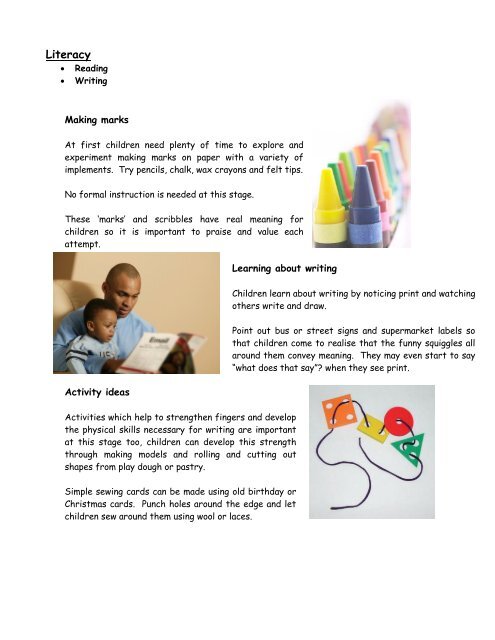The Next Steps - Building on the Foundations
You also want an ePaper? Increase the reach of your titles
YUMPU automatically turns print PDFs into web optimized ePapers that Google loves.
Literacy<br />
Reading<br />
Writing<br />
Making marks<br />
At first children need plenty of time to explore and<br />
experiment making marks <strong>on</strong> paper with a variety of<br />
implements. Try pencils, chalk, wax cray<strong>on</strong>s and felt tips.<br />
No formal instructi<strong>on</strong> is needed at this stage.<br />
<str<strong>on</strong>g>The</str<strong>on</strong>g>se ‘marks’ and scribbles have real meaning for<br />
children so it is important to praise and value each<br />
attempt.<br />
Learning about writing<br />
Children learn about writing by noticing print and watching<br />
o<strong>the</strong>rs write and draw.<br />
Activity ideas<br />
Point out bus or street signs and supermarket labels so<br />
that children come to realise that <strong>the</strong> funny squiggles all<br />
around <strong>the</strong>m c<strong>on</strong>vey meaning. <str<strong>on</strong>g>The</str<strong>on</strong>g>y may even start to say<br />
“what does that say”? when <strong>the</strong>y see print.<br />
Activities which help to streng<strong>the</strong>n fingers and develop<br />
<strong>the</strong> physical skills necessary for writing are important<br />
at this stage too, children can develop this strength<br />
through making models and rolling and cutting out<br />
shapes from play dough or pastry.<br />
Simple sewing cards can be made using old birthday or<br />
Christmas cards. Punch holes around <strong>the</strong> edge and let<br />
children sew around <strong>the</strong>m using wool or laces.

















